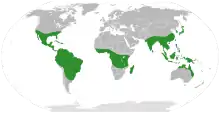| Simaroubaceae | |
|---|---|
 | |
| Ailanthus altissima | |
| Scientific classification | |
| Kingdom: | Plantae |
| Clade: | Tracheophytes |
| Clade: | Angiosperms |
| Clade: | Eudicots |
| Clade: | Rosids |
| Order: | Sapindales |
| Family: | Simaroubaceae DC.[1] |
| Genera | |
|
See text | |
 | |
| Distribution of the family Simaroubaceae. | |
| Synonyms | |
| |
The Simaroubaceae are a small, mostly tropical, family in the order Sapindales. In recent decades, it has been subject to much taxonomic debate, with several small families being split off. A molecular phylogeny of the family was published in 2007, greatly clarifying relationships within the family.[2] Together with chemical characteristics such as the occurrence of petroselinic acid in Picrasma,[3] in contrast to other members of the family such as Ailanthus,[4] this indicates the existence of a subgroup in the family with Picrasma, Holacantha, and Castela.
The best-known species is the temperate Chinese tree-of-heaven Ailanthus altissima, which has become a cosmopolitan weed tree of urban areas[5] and wildlands.[6]
Well-known genera in the family include the tropical Quassia and Simarouba.
Genera
20 genera are accepted:[7]
- Ailanthus Desf.
- †Ailanthophyllum Dawson
- Brucea J.F.Mill.
- Castela Turpin
- Eurycoma Jack
- Gymnostemon Aubrév. & Pellegr.
- Hannoa Planch.
- Homalolepis Turcz.
- Iridosma Aubrév. & Pellegr.
- Leitneria Chapm.
- Nothospondias Engl.
- Odyendea Pierre ex Engl.
- Perriera Courchet
- Picrasma Blume
- Picrolemma Hook.f.
- Pierreodendron Engl.
- Quassia L.
- Samadera Gaertn.
- Simaba Aubl.
- Simarouba Aubl.
- Soulamea Lam.[8]
Excluded genera
- Allantospermum Forman → Ixonanthaceae
- Alvaradoa Liebm. → Picramniaceae
- Desbordesia Pierre ex Tiegh. → Irvingiaceae
- Harrisonia R.Br. ex A.Juss. → Rutaceae
- Irvingia Hook.f. → Irvingiaceae
- Kirkia Oliv. → Kirkiaceae
- Klainedoxa Pierre ex Engl. → Irvingiaceae
- Picramnia Sw. → Picramniaceae
- Recchia Sessé & Moc. ex DC. → Surianaceae[9]
References
- 1 2 "Family: Simaroubaceae DC., nom. cons". Germplasm Resources Information Network. United States Department of Agriculture. 2003-01-17. Retrieved 2011-04-19.
- ↑ Clayton, Joshua W.; Edwino S. Fernando; Pamela S. Soltis; Douglas E. Soltis (2007). "Molecular phylogeny of the tree-of-heaven family (Simaroubaceae) based on chloroplast and nuclear markers". International Journal of Plant Sciences. 168 (9): 1325–1339. doi:10.1086/521796. S2CID 86016778.
- ↑ Tsujimoto, M. and Koyanagi, H. (1933) Bull. Chem. Soc. Jpn. 8, 161
- ↑ T. Stuhlfauth, H. Fock, H. Huber, K. Klug: The distribution of fatty acids including petroselinic and tariric acids in the fruit and seed oils of the Pittosporaceae, Araliaceae, Umbelliferae, Simarubaceae and Rutaceae. In: Biochemical Systematics and Ecology. 13, 1985, S. 447–453, doi:10.1016/0305-1978(85)90091-2.
- ↑ http://www.hort.cornell.edu/uhi/research/articles/jeh4(1).pdf
- ↑ Knapp, Liza B; Canham, Charles D (2000). "Invasion of an Old-Growth Forest in New York by Ailanthus altissima: Sapling Growth and Recruitment in Canopy Gaps". Journal of the Torrey Botanical Society. 127 (4): 307. doi:10.2307/3088649. JSTOR 3088649.
- ↑ Simaroubaceae DC. Plants of the World Online. Retrieved 16 December 2023.
- ↑ "GRIN Genera of Simaroubaceae". Germplasm Resources Information Network. United States Department of Agriculture. Retrieved 2011-04-19.
- ↑ "GRIN genera sometimes placed in Simaroubaceae". Germplasm Resources Information Network. United States Department of Agriculture. Retrieved 2011-04-19.
External links
![]() Media related to Simaroubaceae at Wikimedia Commons
Media related to Simaroubaceae at Wikimedia Commons
![]() Data related to Simaroubaceae at Wikispecies
Data related to Simaroubaceae at Wikispecies